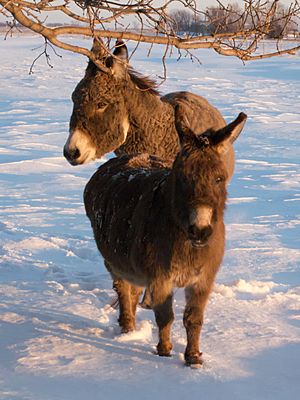North American donkeys facts for kids
North American donkeys are a small part of all the donkeys in the world. Donkeys first came to North America from Europe in the 1400s with Christopher Columbus. They then spread into Mexico. They arrived in what is now the United States in the late 1600s. Many donkeys came to the western United States in the 1800s during the gold rushes. They were used as pack animals (to carry things) and to help in mines. Around 1785, some big donkeys were brought from Europe to the eastern United States. North America doesn't have its own original donkey breeds. Groups in Canada and the United States classify donkeys by their size: miniature, standard, or mammoth. There are also wild donkeys called Burros and a type called Spotted, known for their colors.
Contents
History of Donkeys in North America
Early Arrivals
The first donkeys arrived in the Americas with Christopher Columbus's second trip in 1495. They landed on an island called Hispaniola. In the early days, male donkeys were very important. They were used to breed mules. Mules were special riding animals for the Spanish nobility. Mules were also used for trips to mainland America. Male mules were good for carrying heavy loads. Female mules were used for riding.
The first group of mules, along with some male and female donkeys, came to Mexico from Cuba. This was ten years after the Spanish took over the Aztecs in 1521. Mules helped in silver mines. Each Spanish outpost bred its own mules.
Donkeys in the United States
Donkeys first appeared in what is now the United States around 1679. A priest named Eusebio Kino brought some from Mexico to a new mission in Arizona. Many donkeys came to the western United States during the 1800s gold rushes. They were used as pack animals and for work in mines.
When the mining boom ended and railroads became common, donkeys were not needed as much. Many were set free. These free-roaming donkeys are called burros. They still live in the West today.
Big Donkeys and New Breeds
Around 1785, some large donkeys were brought from Europe to the eastern United States. They were used to make mules. In 1888, a group started keeping records for these big donkeys. They called them American Mammoth Jack. This group later changed its name to the American Mammoth Jackstock Registry. Some European donkey types, like the Maltese and Catalan, might have influenced the Mammoth Jackstock.
In the 1900s, people in the United States started keeping donkeys as pets. In 1929, Robert Green brought seven small donkeys from Sardinia to the United States. These donkeys were called Miniature or Miniature Mediterranean donkeys. Green loved them and said they were very friendly and smart. More Sardinian and Sicilian donkeys were imported later. A special list for miniature donkeys started in 1958. This list later joined with the American Donkey and Mule Society.
Today, groups in Canada and the United States keep records of donkeys. They classify them by size: miniature, standard, or mammoth. These groups also recognize wild Burros and the Spotted donkey, which is known for its unique colors.
Donkey Sizes
Donkey groups in Canada and the United States sort donkeys by their size. They are called miniature, standard, or mammoth donkeys.
- Miniature donkeys are small. They are 36 inches (91 cm) or less tall at their shoulders.
- Small standard donkeys are taller than 36 inches (91 cm) but up to 48 inches (122 cm) tall.
- Large standard donkeys are taller than 48 inches (122 cm). Females are up to 54 inches (137 cm) tall. Males are up to 56 inches (142 cm) tall.
- Mammoth donkeys are the biggest. Females are taller than 54 inches (137 cm). Males are taller than 56 inches (142 cm).
There is also a type called the American Spotted Ass. Any donkey with at least two spots on its body can be registered as an American Spotted Ass.


